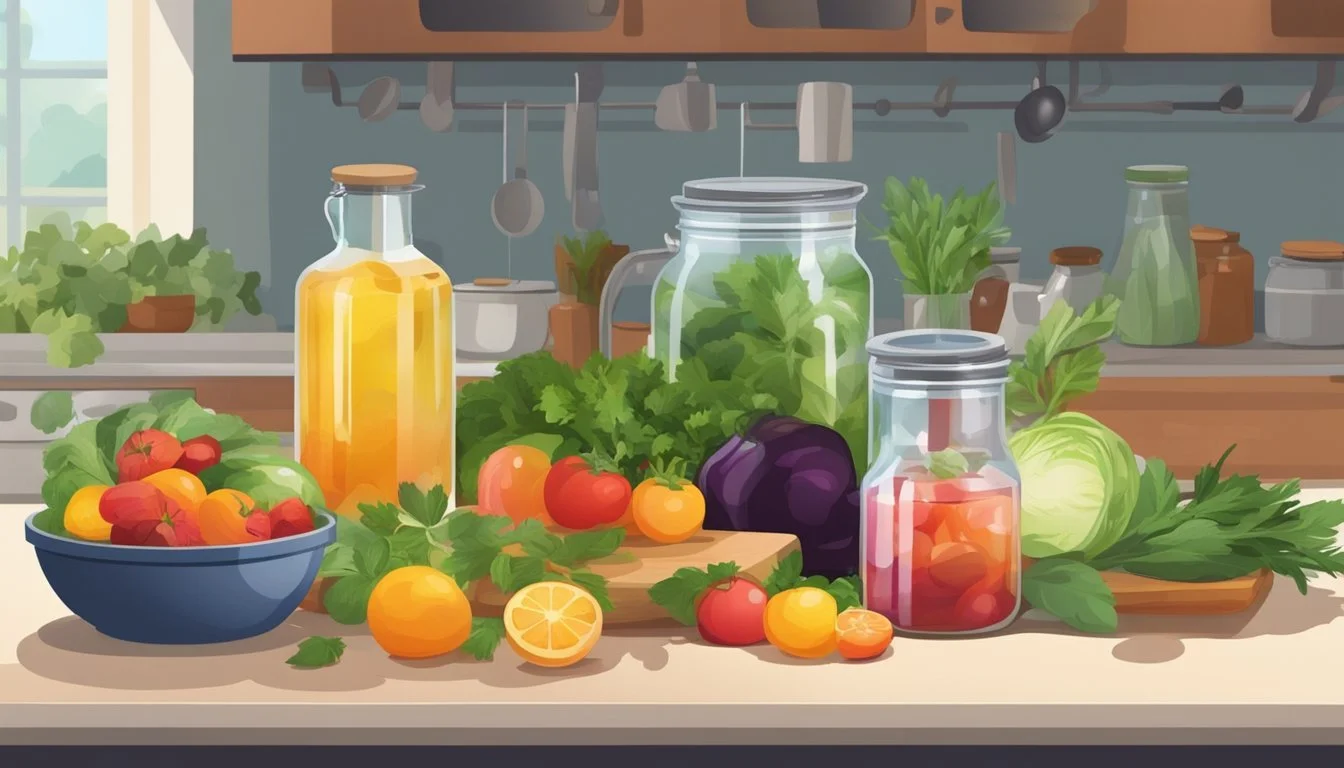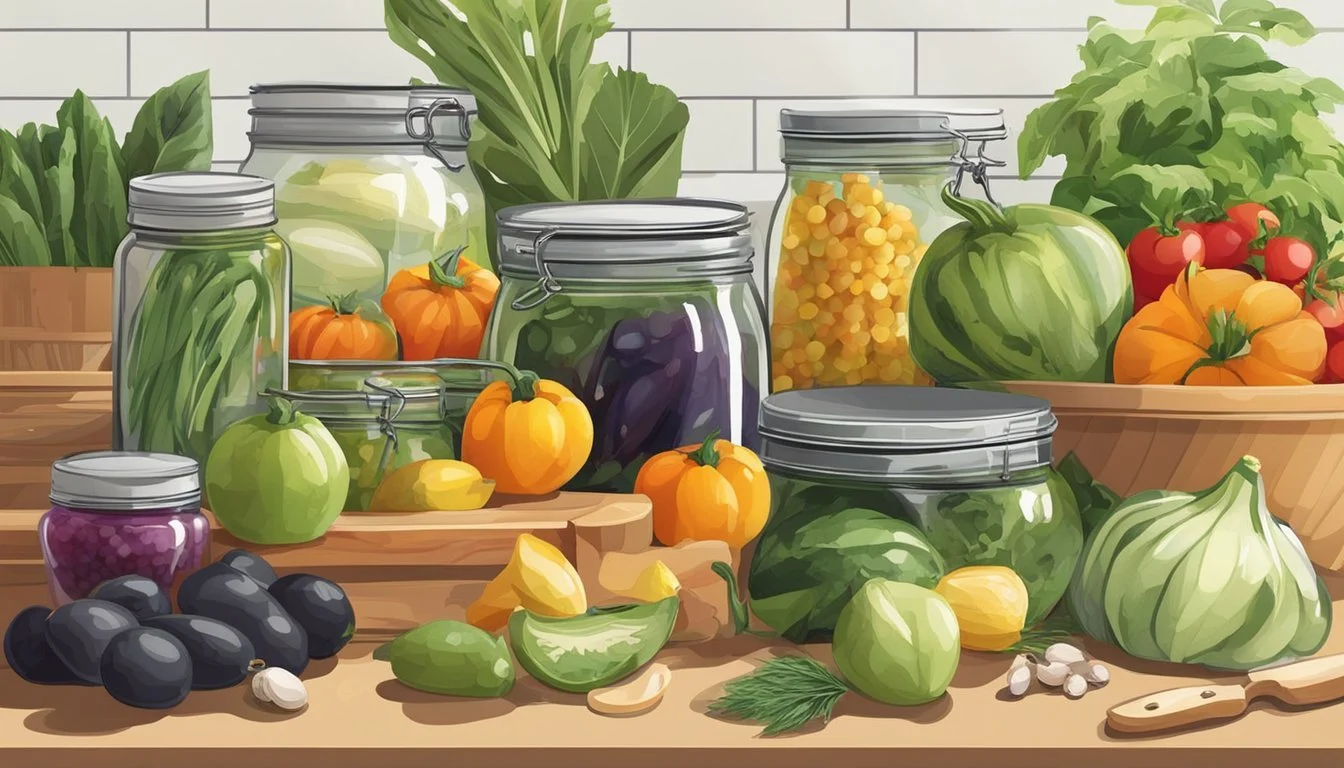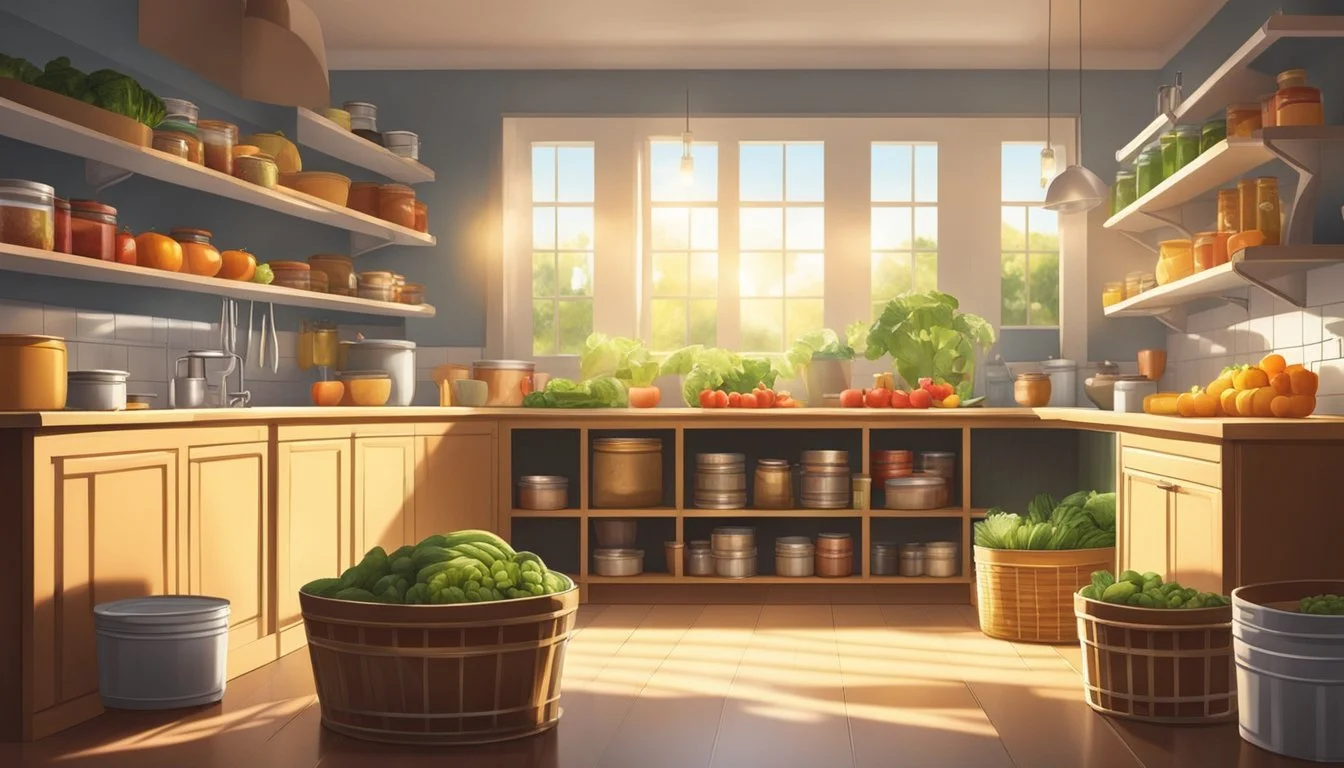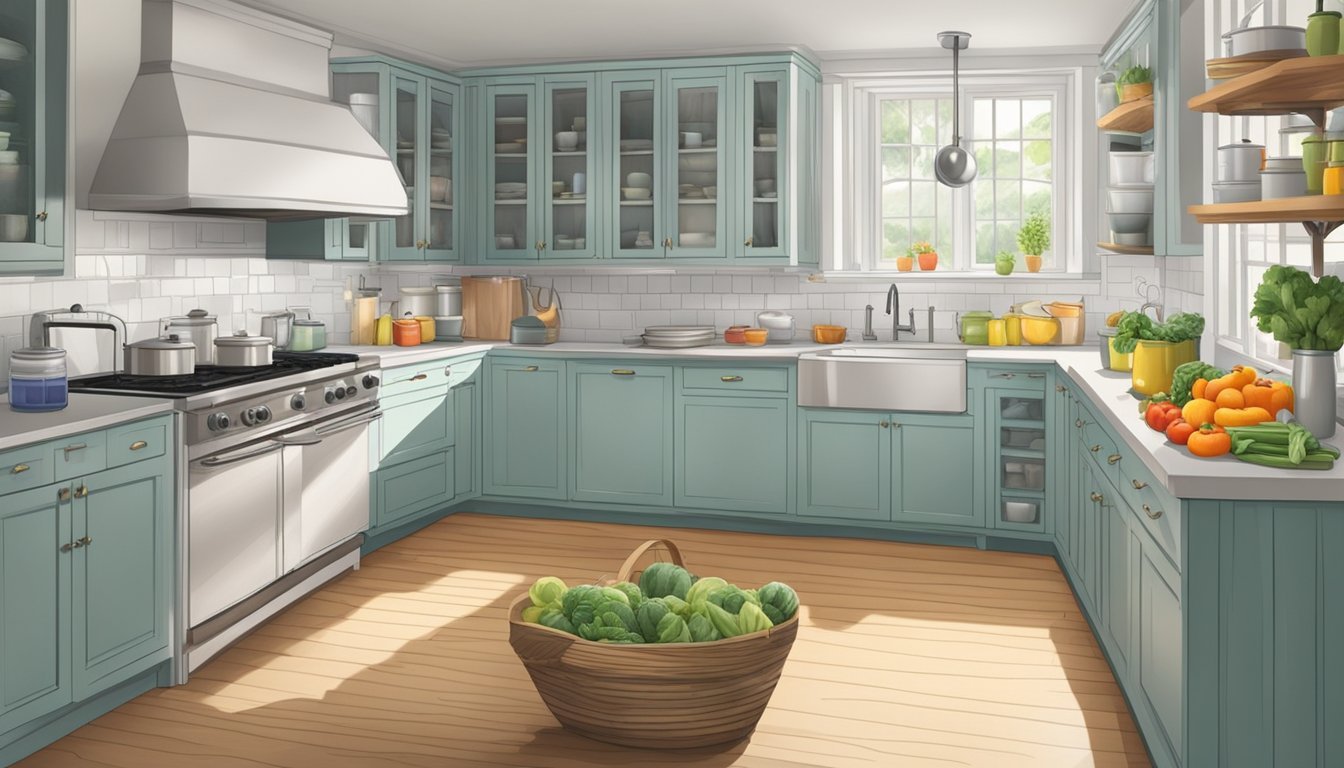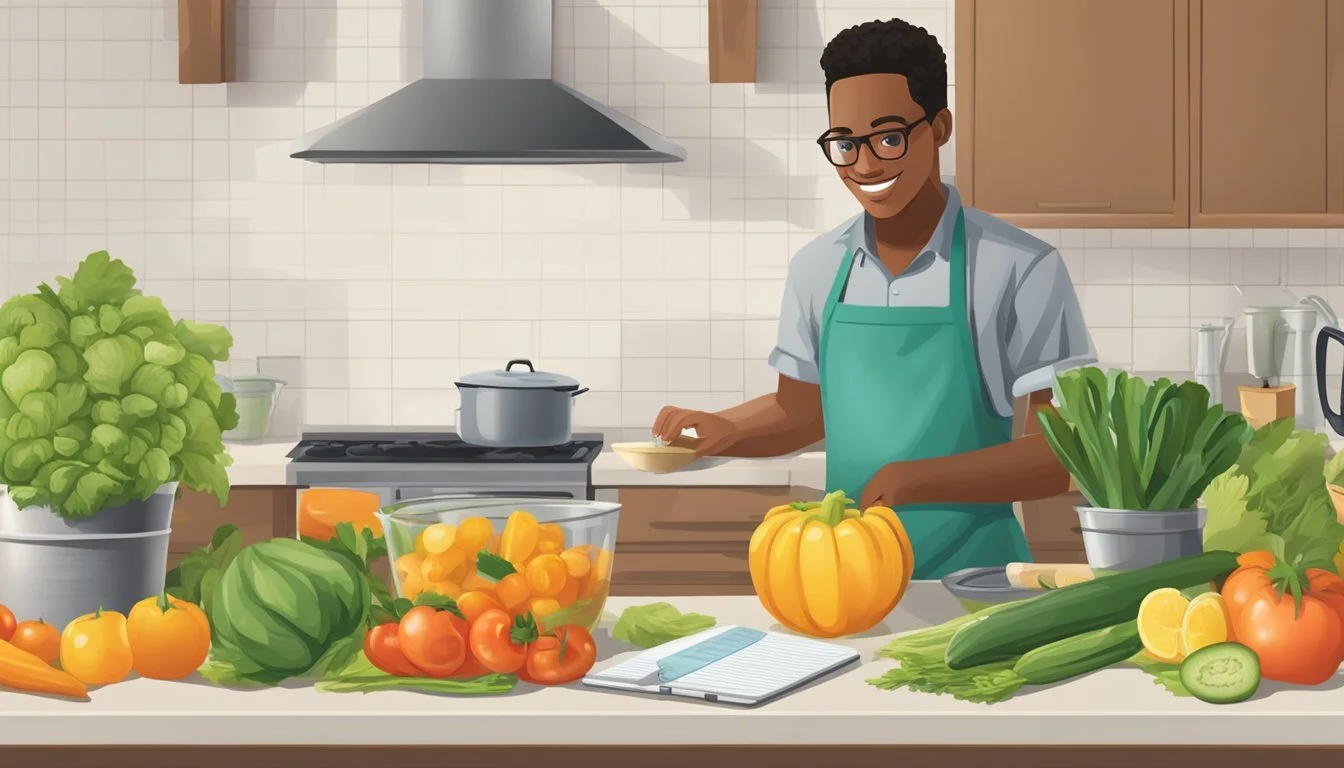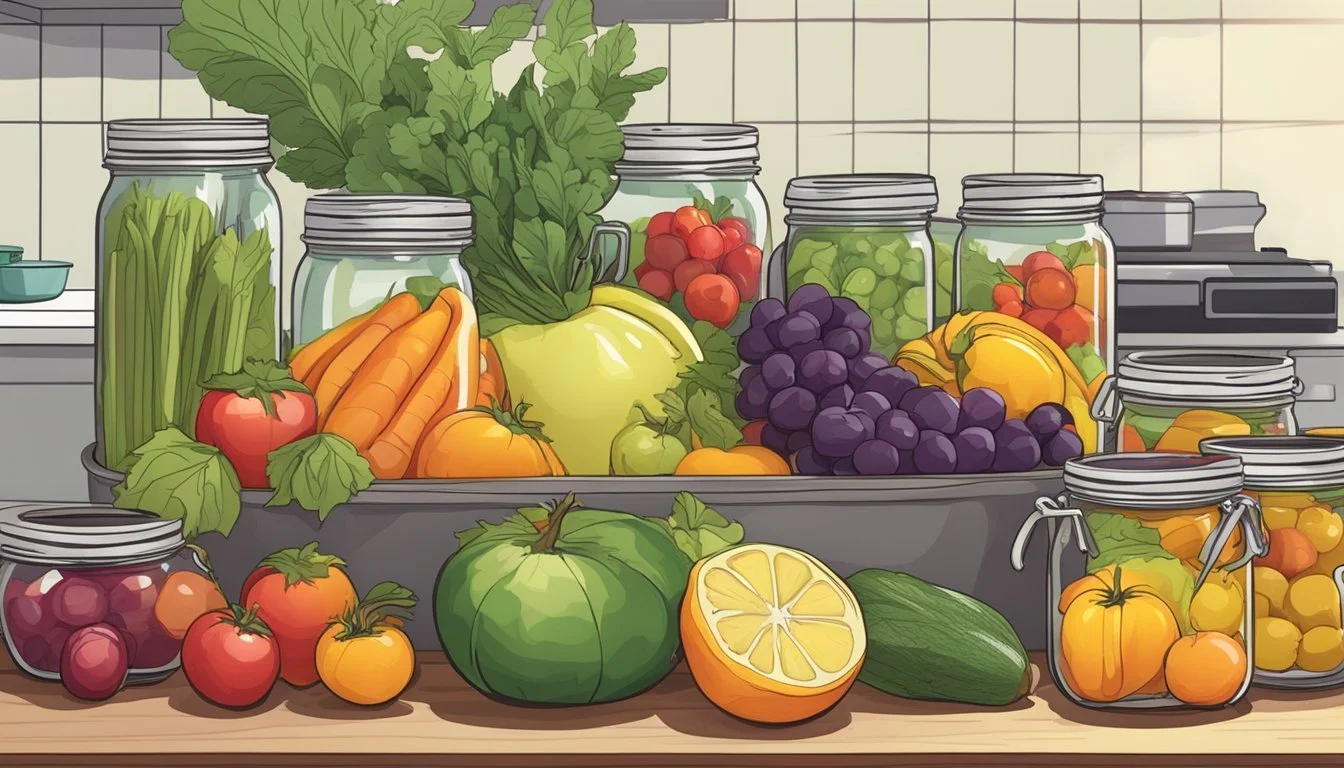How to Cook When You're Trying to Preserve Summer Produce
Seasonal Tips and Techniques
Summer months offer a bounty of fresh produce that not only tantalizes the taste buds but also adds a burst of color and nutrition to every meal. However, as the season fades, so does the availability of these vibrant fruits (What wine goes well with fruits?) and vegetables. To extend the enjoyment of summer produce beyond its natural harvest time, cooking with an eye toward preservation is key. This method ensures that the bright flavors of summer can be savored throughout the year.
Cooking to preserve summer produce involves incorporating techniques that maintain the integrity and quality of fruits and vegetables. The goal is to capture the peak freshness and nutritional value of produce while it is in abundance. This not only maximizes the use of seasonal items but also contributes to reducing food waste, allowing one to enjoy summer flavors even as the seasons change.
Strategic preparation and storage methods such as freezing, making jams, pickling, and creating syrups are employed to keep summer produce on hand. These methods require careful attention to detail to ensure that produce is preserved safely and maintains as much of its original texture and flavor as possible. Cooking with preservation in mind does not mean compromising on taste; rather, it is an invitation to enjoy summer's gifts long after the warm weather has passed.
Understanding Preservation Techniques
Preserving summer produce allows one to enjoy the bounty of the season throughout the year. Different methods suit various types of food and can have a significant impact on the flavor, texture, and nutritional value of preserved produce.
Canning Basics
Canning is a reliable method to preserve fresh produce in airtight containers. To ensure safety and maintain quality, one must sterilize jars and follow precise boiling times for different foods. Fruits typically require a water bath method, while vegetables often need pressure canning due to their lower acidity.
Water bath canning: Ideal for acidic foods like tomatoes and berries.
Pressure canning: Necessary for low-acid foods like green beans and carrots.
Freezing Fundamentals
Freezing is one of the simplest ways to preserve fresh produce, retaining most of its nutrients. One must blanch vegetables to halt enzymatic activity before freezing, which prevents loss of flavor and texture. Fruits can be frozen directly, although adding a sugar syrup or lemon juice may preserve color and taste.
Blanching Time: Varies by vegetable; typically ranges from 2-4 minutes.
Packaging: Use airtight bags or containers to prevent freezer burn.
Drying and Dehydrating
Drying concentrates a food's flavor and is best suited for fruits, herbs, and some vegetables. A dehydrator provides the most consistent results, but an oven on a low setting can work as well. The key is removing moisture slowly at a low heat to prevent cooking.
Temperature: 135-140 degrees Fahrenheit for dehydrators; slightly lower for oven drying.
Preparation: Slice foods evenly to ensure uniform drying.
Pickling and Fermenting
Pickling involves submerging produce in vinegar or a saltwater brine and can introduce unique flavors. Fermenting, on the other hand, relies on natural bacteria to transform the food, enhancing both its taste and nutritional properties. Both methods extend shelf life while adding a distinctive tang.
Brine ratio: Typically a mixture of vinegar, water, salt, and sometimes sugar.
Fermentation: Requires a controlled environment to allow beneficial bacteria to thrive.
Selecting Produce for Preservation
When preserving summer produce, one should prioritize freshness and understand seasonal harvest times to ensure high-quality preservation.
Criteria for Freshness
Preservers should seek out fresh fruits and vegetables, assessing for firmness, vibrant color, and absence of bruises or blemishes. For berries specifically, they should be plump and free from mold. A visual and tactile examination can ensure that the produce is at its peak for preservation.
Firmness: Should yield slightly under pressure but not be mushy.
Color: Look for bright, consistent coloring appropriate to the specific fruit or vegetable.
Blemishes: Avoid produce with cuts, bruises, or other signs of damage.
Seasonal Harvest Times
Understanding seasonal harvest times is key to selecting the best summer produce for preservation. Below is a concise table of typical harvest periods for popular summer produce:
Produce Type Harvest Period Berries Late June to early August Stone Fruits (peaches, cherries) July to August Tomatoes July to September Cucumbers June to August Peppers July to September
These times may vary slightly depending on regional climate variations. By preserving produce at these peak times, one ensures both flavor and nutritional retention.
Preparation and Processing
Before cooking with summer produce that one intends to preserve, there are specific preparation and processing steps that should be followed. Proper cleaning and pre-treatment, blanching techniques, and efficient peeling and chopping methods are essential to maintain the quality and safety of the food during preservation.
Cleaning and Pre-Treatment
To ensure food safety and preserve the quality of the produce, it's imperative to clean fruits and vegetables thoroughly. Soak produce in a solution of one part white vinegar and three parts water for 10 minutes to help remove bacteria and pesticides. After that, rinse them under cold running water. For items like beans, a simple rinse will suffice, while fruits with softer skins may need a softer touch or a specialized fruit cleaner.
Blanching Techniques
Blanching is a technique used to halt enzyme activity that can cause spoilage in produce. Here's how one should blanch different vegetables:
Corn: Blanch the ears for 4-6 minutes depending on size, then immediately plunge them into ice water.
Carrots and bell peppers: Cut as desired and blanch for 2-3 minutes before cooling in ice water.
Tomatoes: To blanch tomatoes, make an 'X' at the base, place in boiling water for 30 seconds, then transfer them to ice water.
Note: Blanching times may vary based on the size and density of the produce.
Peeling and Chopping
After blanching, the skin of some vegetables, like tomatoes, can easily be peeled off. One can use a peeler or pairing knife for carrots, ensuring minimal wastage. When chopping produce, uniformity is key for even preservation – for instance, bell peppers should be cut into consistent strips or dice. Always use a sharp knife and stable cutting board for safety and precision.
Canning Summer Abundance
Canning is a practical method to capture the peak flavors of summer produce. It involves sealing prepared foods in sterilized mason jars, ensuring they are shelf-stable for extended periods.
Tomato-Based Sauces and Salsas
Tomato-based products are a cornerstone of summer canning. Tomato sauce is created by cooking down ripe tomatoes, which can be seasoned to taste and requires a water bath canning method. Tomato salsa, mixing tomatoes with ingredients like onions, peppers, and cilantro, also benefits from the acidity required for safe water bath canning. Properly canned tomato-based sauces (What wine goes well with tomato-based sauces?) and salsas retain the garden-fresh flavors of summer.
Ingredients:
Onions
Garlic
Seasonings (salt, herbs)
Vinegar (for salsa)
Process:
Sanitize mason jars and lids.
Cook the tomato mixture until desired consistency.
Fill jars, leaving adequate headspace.
Process in a water bath canner for the time specified in a trusted recipe.
Fruit Jams and Jellies
Jams and jellies made from summer fruits like berries capture the essence of the season in a spreadable form. These preparations generally require the fruit to be cooked with sugar, and pectin may be added to ensure proper setting. The use of a water bath canning method is essential here to preserve the fruit's vibrant taste and color.
Ingredients for Jam:
Fresh berries (strawberries, blueberries, raspberries)
Sugar
Pectin (if needed)
Ingredients for Jelly:
Fruit juice (from berries or other summer fruits)
Sugar
Pectin
Process:
Combine fruits with sugar (and pectin if needed) and bring to a boil.
Pour into sterilized jars, ensuring proper headspace.
Process the jars in a water bath canner according to safe canning guidelines.
Vegetable Relishes
Vegetable relishes, including those made from cucumbers like sweet pickles and relishes, are another canning favorite. The key to a safe and crunchy relish is the use of a pickling solution containing vinegar which acts as a natural preservative.
Ingredients:
Fresh cucumbers
Onions
Spices (mustard seeds, celery seeds, turmeric)
Salt
Vinegar
Process:
Chop vegetables finely and combine with vinegar, spices, and salt.
Cook the mixture briefly.
Pack into sanitized jars, leaving proper headspace.
Process in a water bath canner, following a reliable recipe.
Freezing for Freshness
Freezing is a practical way to preserve the bounty of summer produce, locking in nutrition and flavor. Proper techniques can ensure fruits, vegetables, and herbs maintain their quality throughout the colder months.
Fruit Preservation
To freeze fruit, one should first wash and dry it thoroughly. Berries can be placed on a tray lined with baking paper and frozen until solid before transferring to freezer bags. This prevents the fruit from clumping together. For fruits like peaches and plums, remove the pit and slice before freezing. A helpful tip: sprinkling a little sugar on fruit before freezing can help preserve color and flavor.
Berries: Freeze on a tray, transfer to a bag once solid.
Peaches/Plums: Pit, slice, optionally sprinkle with sugar, then freeze.
Freezing Vegetables
For vegetables, blanching before freezing is crucial. Blanching involves boiling vegetables for a short time and then plunging them into ice water to halt cooking. It helps maintain color and texture. Vegetables like zucchini and peppers should be sliced or chopped to uniform size for even freezing.
Zucchini/Peppers: Blanch, then freeze in a single layer.
Corn: Blanch whole ears, cool, cut off kernels, and freeze.
Herbs and Leafy Greens
Herbs and leafy greens need special attention when freezing. Herbs can be chopped and frozen in ice cube trays with water or oil for easy addition to recipes. Greens like spinach and kale should be washed, blanched, and dried thoroughly.
Herbs: Chop, place in trays with water/oil, freeze cubes.
Spinach/Kale: Blanch, drain well, and freeze flat in bags.
By following these freezing methods, you retain the fresh taste of summer even as the seasons change.
Drying Methods
Preserving summer produce by drying is an effective way to extend the shelf life of your fruits and vegetables. Each drying method varies by the equipment used, preparation time, and the type of produce best suited for the technique.
Using a Dehydrator
A dehydrator provides a controlled environment for drying fruits and vegetables. Beans, tomatoes, peppers, and zucchini are all ideal candidates for this method. Dehydrators circulate warm, dry air around the food, removing moisture while retaining much of the nutrition and flavor. It's important to cut produce into uniform pieces to ensure even drying. The dehydrator's consistent temperature helps prevent the risk of mold and can be a good investment for regular use.
Air-Drying Techniques
Air-drying is suited best for herbs and other produce with low moisture content. Bunches of herbs can be dried by tying them together and hanging them in a warm, dry, and well-ventilated space away from direct sunlight. Peppers are also amenable to air-drying, often by stringing them together to create ristras where they benefit from good air circulation. This method does not require special equipment but does depend heavily on ambient conditions.
Oven Drying
For individuals without special equipment, an oven can serve as a dehydrator alternative. One can dry small batches of produce by setting the oven at the lowest possible temperature, arranging the produce in a single layer on a baking sheet, and leaving the door slightly ajar to allow for air circulation. Oven drying is more energy-intensive and requires frequent checks to avoid scorching the food, particularly delicate items like tomato slices or zucchini. Oven drying is often slower than using a dehydrator but is a good option for occasional drying.
Fermentation and Pickling
Preserving the bounty of summer produce can be efficiently accomplished through fermentation and pickling. These methods not only extend the shelf life of foods but also enhance their flavors and nutritional value.
Making Sauerkraut
Making sauerkraut involves the fermentation of cabbage. Begin by thinly slicing the cabbage and combining it with salt in a large bowl. As the cabbage releases its liquid, a brine forms when massaged into the cabbage leaves. This brine creates an anaerobic environment for beneficial bacteria to thrive. Transfer the mixture into a clean jar, pressing it down until the brine rises above the cabbage. Seal the jar with a fermentation weight to keep the cabbage submerged, and cover it with a breathable cloth. It should be kept at room temperature for several days or until it reaches the desired level of sourness.
Cabbage Salt 1 medium head (shredded) 1 tablespoon
Quick Pickling Vegetables
Quick pickling, also known as refrigerator pickles, can be done with a variety of vegetables, including cucumbers, carrots, and beans. The process starts with preparing a solution of vinegar and water, to which salt, sugar, and aromatics like garlic, dill (how long does dill last?), and peppercorns are added for flavor. Vegetables are then packed into jars, covered with the hot pickling solution, and allowed to cool. Once cooled, the jars should be sealed and refrigerated. Refrigerator pickles are ready to eat in as little as 24 hours and can be stored in the refrigerator for up to a month.
Ingredients for Pickling Solution:
(\frac{1}{2}) cup vinegar (white or apple cider)
(\frac{1}{2}) cup water
1 tablespoon kosher salt
1 tablespoon sugar (optional)
Seasonings (garlic, dill, peppercorns, etc.)
Fermented Condiments
Condiments like pesto can also be made more preservable by incorporating fermentation. For example, fermenting peppers with garlic can create a spicy, tangy base for a variety of sauces or spreads. To ferment condiments, similar to sauerkraut, the vegetables and herbs are combined with salt to create a brine. This mixture is then packed into jars, ensuring there's enough liquid to submerge the solids. A fermentation weight may be used to keep the ingredients below the brine. The jars are left to sit at room temperature for several days until the mixture reaches the desired flavor profile.
Basic Fermented Condiment Recipe:
Vegetables or herbs (peppers, garlic, etc.)
1-3% of the produce weight in salt
Water, as needed to form brine
By utilizing these methods, one can effectively preserve the summer's harvest while also enjoying the health benefits and unique flavors offered by fermented and pickled foods.
Long-Term Storage Considerations
When preserving summer produce for long-term storage, three key factors ensure quality and taste: protecting against freezer burn, using the right packaging materials, and appropriately utilizing root cellar conditions.
Preventing Freezer Burn
Freezer burn occurs when air reaches the food's surface, leading to dehydration and oxidation. To prevent this:
Wrap items in cling film or aluminum foil before placing them in freezer bags to create an extra barrier against air.
Place a layer of paper towel inside the packaging to absorb any moisture.
Packaging for Preservation
The choice of containers is vital to limiting exposure to air and maintaining freshness:
Mason jars are ideal for liquids and small produce, but ensure they are tempered to withstand freezing.
Air-tight containers are essential. For solid foods like berries or chopped vegetables, press as much air out of freezer bags as possible before sealing.
Root Cellar Storage
The root cellar provides the perfect environment, balancing humidity and temperature for certain items:
Use containers like wooden crates or baskets lined with straw to allow for air circulation around root vegetables.
Keep a consistent temperature between 32-40°F (0-4°C) and humidity at 85-95% for optimal storage conditions.
Creative Uses of Preserved Produce
Harnessing the tastes of summer throughout the year is possible through the thoughtful preservation of produce. This section dives into recipes and culinary applications, showcasing how different preservation methods can transform frozen, canned, and dried produce into unexpected and delightful dishes.
Recipes Incorporating Frozen Foods
Frozen vegetables maintain much of their texture and flavor, making them ideal for soups and stews. For example:
Corn Chowder: Utilize frozen corn to create a creamy and comforting chowder.
Pea Risotto: Stir in frozen peas towards the end of cooking for a fresh, vibrant touch.
Dishes with Canned Ingredients
Canned vegetables and fruits can become the star of many recipes. Their intense flavors enrich various courses:
Bean Chili: Canned beans are the foundation for a hearty, robust chili.
Carrot Cake: Canned carrots provide moistness and sweetness to the classic dessert.
Snacks and Condiments from Dried Produce
Dried fruits (What wine goes well with dried fruits?) and vegetables offer concentrated flavors and a longer shelf life, ideal for snacks or enhancing other dishes:
Berries in Cereal: Add dried berries to granola or cereal for a nutritious twist.
Squash Bread: Incorporate dried squash into bread for added flavor and texture.
Health and Safety in Preservation
When preserving summer produce, it is crucial to manage health and safety risks. Proper sterilization techniques are essential to prevent bacterial contamination, and the retention of nutritional value is paramount to ensure the preserved food is as healthy as it is delicious.
Sterilization and Food Safety
Sterilization is a critical step in the preservation process to eliminate harmful bacteria. During canning, all jars and lids must be sterilized before use. One can boil these containers for at least 10 minutes to ensure they are safe for storing food. Additionally, the pressure canning method is recommended for low-acid foods, like vegetables, to prevent botulism, a potentially fatal illness caused by bacteria.
For vinegar-based preservation methods like pickling, the acidity of vinegar acts as a natural disinfectant, which can inhibit bacterial growth. However, maintaining the correct pH level is vital; it should be at or below 4.6.
Nutritional Value Retention
Preserving food not only extends its shelf life but can also retain its nutritional value if done correctly. Freezing is an excellent method for preserving the nutrition of summer produce. It slows down the enzymatic decay of food and retains most vitamin content. Freeze fruits and vegetables at their peak ripeness to maximize nutrient retention.
Drying or dehydrating fruits and vegetables is another effective preservation method that can retain a significant amount of nutrients. However, some vitamins that are sensitive to heat and air, such as Vitamin C, can diminish during the drying process. To maintain a more nutritious yield, drying should be done at lower temperatures, and produce should be stored in airtight containers after dehydration.
Tips and Techniques for Beginners
Preserving summer produce allows one to enjoy the bounty of the season year-round. Proper equipment selection and understanding the timing of preservation methods are pivotal for beginners initiating this culinary venture.
Selecting the Right Equipment
To embark on the preservation journey, one must start with the appropriate tools. Canning requires a canner, jars with lids and rings, a jar lifter, and a funnel. For freezing, one should acquire airtight containers or freezer bags, along with a blanching basket for boiling water blanching of vegetables. Drying fruits and vegetables is most effective with a dehydrator, though an oven on a low setting can be used in its absence. Each piece of equipment should be in good condition and suitable for the type of preservation.
Preservation Method Essential Equipment Canning Canner, jars, lid, lifter Freezing Airtight containers, bags Drying Dehydrator or oven
Timing and Batching Work
One should attentively manage the timing of preservation activities. When canning, foods must be processed for the precise amount of time specified in reliable recipes to ensure safety and taste. Blanching for freezing should last only as long as necessary to inactivate enzymes—typically 2-4 minutes—followed immediately by cooling in ice water. When using a dehydrator, time varies based on fruit or vegetable type, which stresses the importance of using timers and ensuring your dehydrator has accurate temperature control. One can batch their work by timing tasks such as chopping or blanching while waiting for cans to process or the dehydrator to complete its cycle.
Canning: Use a quality timer, process as per recipe.
Freezing: Blanch briefly, then quick-cool.
Drying: Temperature and timing depend on produce class.
Maximizing Flavor and Texture
When cooking to preserve summer produce, one's goal is to maintain the natural flavor and texture. Selecting the right produce and understanding how to balance flavors are crucial.
How to Choose Seasonal Produce
Taste and freshness are paramount when selecting seasonal vegetables and fruits. For the best outcomes:
Look for fruits and berries that are plump and vibrant in color.
Pick vegetables that are firm and display no signs of wilting.
Sniff produce, as it should have a fresh, earthy smell, indicative of its quality.
Produce such as berries may be briefly submerged in hot water (around 120-130°F) and then gently spun dry to maintain texture before canning or freezing. Using this technique with fragile fruits helps in eliminating bacteria without cooking them.
Balancing Sweetness and Acidity
To preserve the taste when cooking summer produce:
Enhance the natural sweetness of fruits by creating a syrup with equal parts sugar and water, infused with a handful of the fruit or complementary fresh herbs.
Balance acidity in foods by incorporating ingredients like lemon juice or vinegar, especially when canning. These not only help preserve the food but also add a pop of flavor that heightens the overall taste.
Adjust sugar levels based on the natural sweetness of the fruit being preserved; overly ripe fruits may require less additional sweetening.
Consistently tasting and adjusting as one cooks can assure that the flavors are well-balanced and the natural taste of the produce is highlighted.
Budgeting and Economic Benefits
Preserving summer produce not only extends the enjoyment of seasonal flavors but also offers considerable cost savings and the delight of sharing homemade goods with others.
Cost-Effective Preservation Choices
When one preserves summer produce, significant savings can occur. For instance, purchasing vinegar in bulk for pickling or canning can reduce costs substantially. Here are specific ways to save money:
Bulk Buying: Acquiring large quantities of vinegar, sugar, and other preserving agents during sales can decrease the overall expense of preservation.
Seasonal Purchasing: Buying fruits and vegetables in season when prices are lowest for freezing or canning can lead to considerable savings.
Organic Options: Opting for organic produce can be more expensive upfront, but preserving it helps bring down the cost per meal when used in recipes throughout the year.
Sharing the Bounty with Friends and Family
Sharing preserved goods with friends and family not only fosters community but also has economic benefits:
Dividing Costs: The materials and fresh produce costs can be split among those who wish to share the end products.
Bulk Preparation: Preparing large batches together saves time and resources, reducing the cost per unit for everyone involved.
By intelligently selecting preservation methods and ingredients, one can enjoy the tastes of summer year-round in a cost-effective manner, while also providing a means to share with those around them.
Conclusion
Preserving summer produce effectively ensures that one can enjoy the bounty of the season well into the colder months. The various methods of preservation discussed enable cooks to maintain the taste and nutritional value of their fresh vegetables and fruits. One must select the method that best suits the type of produce and the desired usage in future culinary pursuits.
Freezing allows for preserving the freshness of produce, retaining most of its nutritional content.
Canning provides long-term storage and can impart a unique flavor, particularly with pickled items.
Dehydration is excellent for concentrating flavors and creating convenient, space-saving storage.
When incorporating preserved produce into cooking, attention should be paid to adjusting recipes to account for changes in texture or concentration of flavors. Seasonal produce that is captured at its peak can bring extraordinary taste to a meal and nutritional benefits to one's diet throughout different seasons.
One should also be diligent about labeling and dating the preserved items, as this aids in keeping track of their shelf life and ensures that nothing goes to waste. Lastly, experimenting with different preservation techniques can not only be a rewarding culinary experience but also a step towards sustainable living and reducing food waste.

